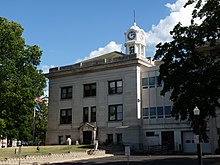Sauk County, Wisconsin
| Sauk County, Wisconsin | |
|---|---|

Sauk County Courthouse in June 2012
|
|
 Location in the U.S. state of Wisconsin |
|
 Wisconsin's location in the U.S. |
|
| Founded | 1844 |
| Seat | Baraboo |
| Largest city | Baraboo |
| Area | |
| • Total | 849 sq mi (2,199 km2) |
| • Land | 831 sq mi (2,152 km2) |
| • Water | 18 sq mi (47 km2), 2.1% |
| Population | |
| • (2010) | 61,976 |
| • Density | 75/sq mi (29/km²) |
| Congressional district | 2nd |
| Time zone | Central: UTC-6/-5 |
| Website | www |
Sauk County is a county in Wisconsin. It is named after a large village of the Sauk people. As of the 2010 census, the population was 61,976. Its county seat and largest city is Baraboo. The county was created in 1840 from Wisconsin Territory and organized in 1844.
Sauk County comprises the Baraboo, WI Micropolitan Statistical Area and is included in the Madison-Janesville-Beloit, WI Combined Statistical Area.
Sauk County was a New England settlement. The original founders of Sauk County consisted entirely of settlers from New England as well as some from upstate New York who had parents that moved to that region from New England shortly after the American Revolution. These people were "Yankee" settlers, that is to say they were descended from the English Puritans who settled New England in the 1600s. While most of them came to Wisconsin directly from New England, there were many who came from upstate New York. These were people whose parents had moved from New England to upstate New York in the immediate aftermath of the American Revolution. They were part of a wave of New England farmers who headed west into what was then the wilds of the Northwest Territory during the early 1800s. In the case of Wisconsin this migration primarily occurred in the 1830s. Due to the prevalence of New Englanders and New England transplants from upstate New York, Wisconsin was very culturally continuous with early New England culture for much of its early history.
...
Wikipedia
